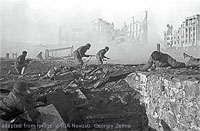A Message to Putin From 42 Million Dead; The Soviet Union’s World War II losses may far exceed the official count.

(Bloomberg – bloomberg.com – Leonid Bershidsky – May 10, 2017)
Leonid Bershidsky is a Bloomberg View columnist. He was the founding editor of the Russian business daily Vedomosti and founded the opinion website Slon.ru.
According to official data, more than 800,000 people in Moscow alone, including Russian President Vladimir Putin, took part in Tuesday’s march to commemorate their ancestors’ participation in World War II. This memory is the basis of the Putin school of Russian patriotism and a big part of the ideology underlying the nation’s recent geopolitical assertiveness. But the so-called Immortal Regiment movement also has another side, which undermines this ideology: Its leaders claim that declassified data show the Soviet Union’s wartime losses reached an astronomical 42 million people, rather than the officially recognized 27 million.
The Immortal Regiment — the tradition of people marching with the photographs of their relatives who fought in the war to mark the anniversary of the Soviet victory on May 9 — started as a grassroots movement in the 2000s; three journalists in Tomsk named it. The Kremlin’s decision to head up the marches has had the effect of replacing the patriotic spontaneity of local activists with the dutifulness of an official propaganda effort specifically aimed at making the 1945 victory the cornerstone of Russian national pride. Organizers have quarreled about the degree of closeness to the official authorities, with the Moscow chapter of Immortal Regiment splitting off to go along entirely with the Kremlin effort.
Something about the original urge, however, has resisted the government’s narrative: The people in those pictures are, after all, are almost all dead. Many of them were killed in a war that decimated the Soviet Union’s population, sometimes leaving entire extended families and even villages without men.
In February, the Russian parliament held a hearing on the Immortal Regiment movement as an element of young Russians’ “patriotic upbringing.” The many parliamentary and government bodies who decided to participate was an unambiguous signal that support came from the highest level. As he opened the hearing, legislator Vyacheslav Nikonov spoke of defending Russia’s victory against a hybrid attack and a resurgence of Nazism in Ukraine. But another legislator, Nikolai Zemtsov, who was one of the movement’s early organizers and one of the strongest officialization advocates, delivered a somewhat unexpected contribution.
In a report to the hearing, Zemtsov said that according to data declassified in the post-Soviet years, 41.979 million Soviet citizens died in World War II — about 19 million soldiers and 23 million civilians.
The World War II casualty count has always been a matter of government policy in Russia. Josef Stalin had stuck to a low estimate Soviet losses — 7 million; Nikita Khrushchev then admitted 20 million lives were lost, and that was the number I was taught while attending a Soviet school in the 1970s and 1980s. In the Soviet Union’s final years, under President Mikhail Gorbachev, the official count rose to 27 million. It was an uncomfortable number: Germany only lost 7.3 million people, according to the official count, which some historians argue is low. Such an enormous cost of the Soviet victory gave rise to questions about Stalin’s conduct of the war and the value the victorious Soviet state attached to human life.
The 27 million number has held up since. Putin has used it in speeches. General Grigory Krivosheev’s definitive, state-sponsored work from 2009, “The Great Patriotic War Declassified,” put the final figure at 26.6 million. The number, however, was based on certain census data extrapolations. Zemtsov’s estimate, based on the work of historian Igor Ivlev, doesn’t rely on them. The State Planning Committee, the statistical and quota-setting center of the Soviet planned economy, had more specific numbers. Ivlev argued, however, that those data didn’t include service members, who were accounted for separately.
In total, according to Ivlev, the Soviet Union had a population of 205 million in 1941 and 169.8 million in 1945. Taking into account the 17.6 million births and natural deaths at the 1941 level, that leaves almost 42 million in war-related losses.
Though Ivlev’s approach has been questioned by some historians, his headline number is now bandied about semi-officially but by people responsible for using the memory of the war for “patriotic upbringing.” If it’s correct, it drives home the vastness of Russia’s tragedy and the price the country paid to rid the world of Nazism — but it also describes a Pyrrhic victory by a dictator who didn’t care how many people died following his orders. The cockiness of the victory anniversary celebrations since the 2014 invasion of Crimea and the ubiquitous cries of “We can do it again” are downright macabre next to Ivlev’s casualty number.
Given the size of its sacrifice, Russia is a country that should be less belligerent than any other nation in the world — even less than Germany, which has consciously kept its military activity at a low level even despite completely shedding the legacy of its aggressive 20th century rulers. If indeed it lost a quarter of its population in World War II, it should be committed to never “doing it again.” Putin’s depredations against neighboring nations and his willingness to intervene militarily far from Russia’s borders ignore the somber memories the Immortal Regiment evokes.
Even victories can carry an unthinkable cost. Putin might want to ponder that as he walks with the crowd, carrying the portrait of his father, who fought in the war and was lucky enough to come back — but not his brother Viktor, who died from diphtheria in Nazi-besieged Leningrad.
©2017 Bloomberg L.P. All Rights Reserved. Article also appeared at bloomberg.com/view/articles/2017-05-10/a-message-to-putin-from-42-million-dead
